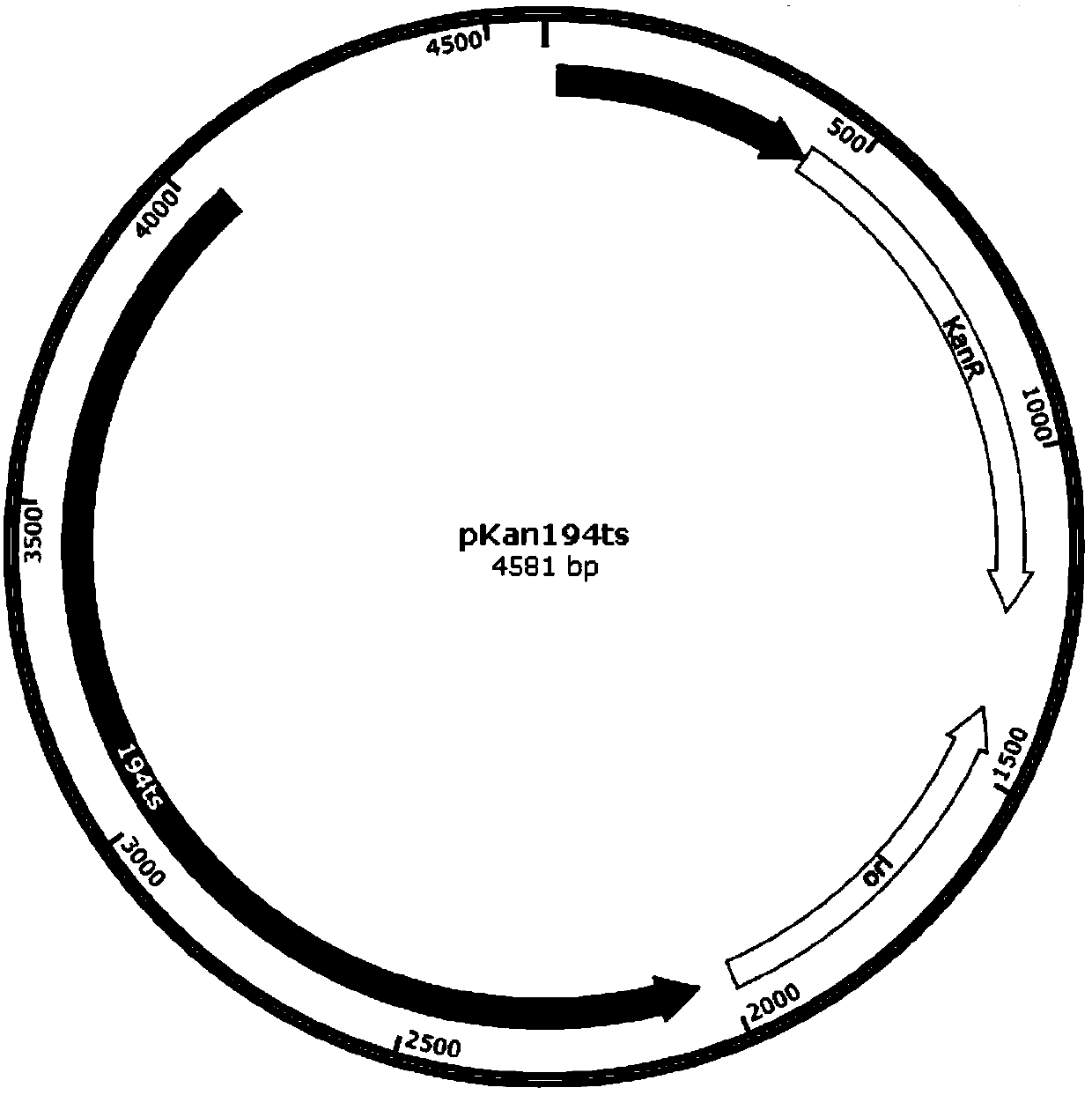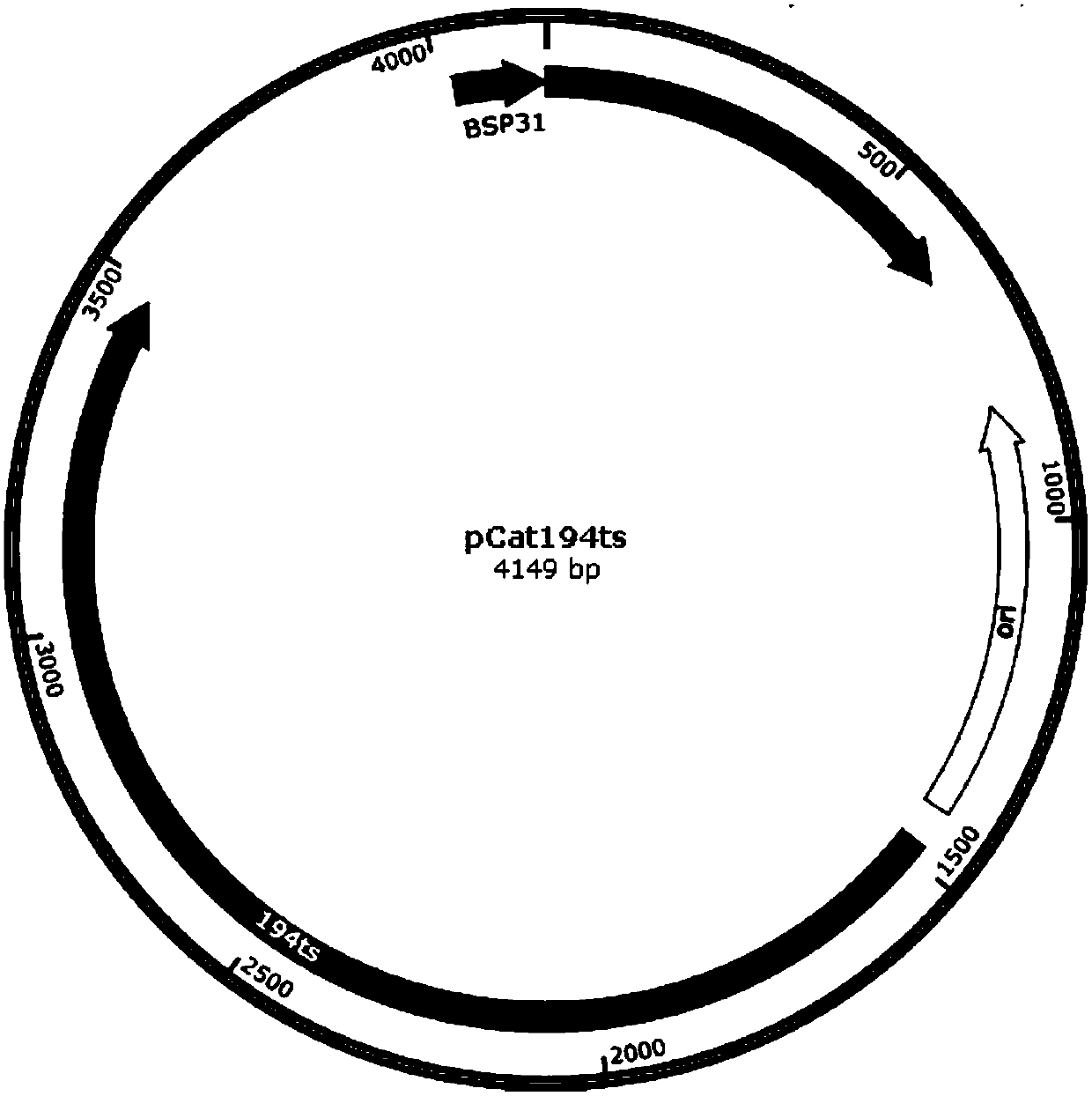A kind of Bacillus multiple gene overlay knockout method
A Bacillus, multi-gene technology, applied in the field of microbial genetic engineering, can solve problems such as low efficiency, achieve the effects of improving efficiency, avoiding recovery, and improving the efficiency of transformation
- Summary
- Abstract
- Description
- Claims
- Application Information
AI Technical Summary
Problems solved by technology
Method used
Image
Examples
example 1
[0051] Example 1 Construction of thermosensitive knockout plasmid pKan194ts
[0052] 1. Use the pE194 plasmid as a template, and use primers F1 and R1 (see Table 1 for primers) to amplify the thermosensitive replicon 194ts fragment of the vector; the PCR system is: 10×PCRBuffer 5 μL, 2mM dNTPS 5 μL, 25mM MgSO 4 5 μL, 1.5 μL each of 10 μM primer F / R, 0.5 μL template DNA, 1 μL KOD-Plus-Neo, dH 2 O 32.5 μL; PCR reaction conditions are as follows: 94°C, 30 cycles (98°C for 10 s, 58°C for 30 s, 68°C for 1.5 min), 68°C for 5 min, and 4°C for incubation. In subsequent experiments, the PCR system and reaction conditions were configured and set according to the above conditions, the annealing temperature and extension time were adjusted according to the actual situation, and other parameters remained unchanged.
[0053] 2. Refer to the method in the CN201410430501.3 patent document to construct the pWEBK15 plasmid. The specific construction method is as follows:
[0054] Extract pET...
example 2
[0059] Example 2 Construction of thermosensitive knockout plasmid pCat194ts
[0060] 1. Use the pE194 plasmid as a template, and use primers F1 and R1 to amplify the thermosensitive replicon 194ts fragment of the vector.
[0061] 2. Refer to the method in CN201410430501.3 patent document to construct pWEBC26 plasmid. The build method is as follows:
[0062] Extract the pWEBK15 plasmid, digest it with EcoR V and Pci I, and recover a large fragment of about 1500bp with the DNA gel recovery kit. Using the genomic DNA of Bacillus licheniformis ATCC14580 as a template, using synthetic P9 (CGAGATATCATGAATTTTCAAACAATCGAGC) and P10 (CCCACATGTACAGAAAGTTTGTTGAGAGC) as primers to amplify the chloramphenicol resistance gene Cat, EcoR V and Pci I double enzyme digestion, PCR product purification kit purification Digested fragments. EcoR V and Pci I double-digested vector fragments and Cat gene fragments were ligated and transformed into Escherichia coli DH5α, spread on LB solid medium pla...
example 3
[0065] Example 3 Construction of thermosensitive knockout plasmid pTet194ts
[0066] Using the pHY300PLK plasmid as a template, the tetracycline resistance gene Tet was amplified with primers F4 and R4; using the plasmid pKan194ts as a template, the upstream and downstream primers F5 and R5 were used for PCR amplification of the whole plasmid, and the amplified product was digested with Dpn I overnight at 37°C After recovery, the carrier fragment and gene fragment were connected using the operation instructions of the seamless cloning kit, transformed into Escherichia coli JM110, coated on a 10 μg / ml tetracycline-resistant LB plate, and cultured at 30°C for 20 hours to screen clones. Primers R3 and P1 were verified by PCR and sequencing. The vector with successful sequencing was named pTet194ts. For the plasmid map, see Figure 4 .
PUM
 Login to View More
Login to View More Abstract
Description
Claims
Application Information
 Login to View More
Login to View More - R&D
- Intellectual Property
- Life Sciences
- Materials
- Tech Scout
- Unparalleled Data Quality
- Higher Quality Content
- 60% Fewer Hallucinations
Browse by: Latest US Patents, China's latest patents, Technical Efficacy Thesaurus, Application Domain, Technology Topic, Popular Technical Reports.
© 2025 PatSnap. All rights reserved.Legal|Privacy policy|Modern Slavery Act Transparency Statement|Sitemap|About US| Contact US: help@patsnap.com



